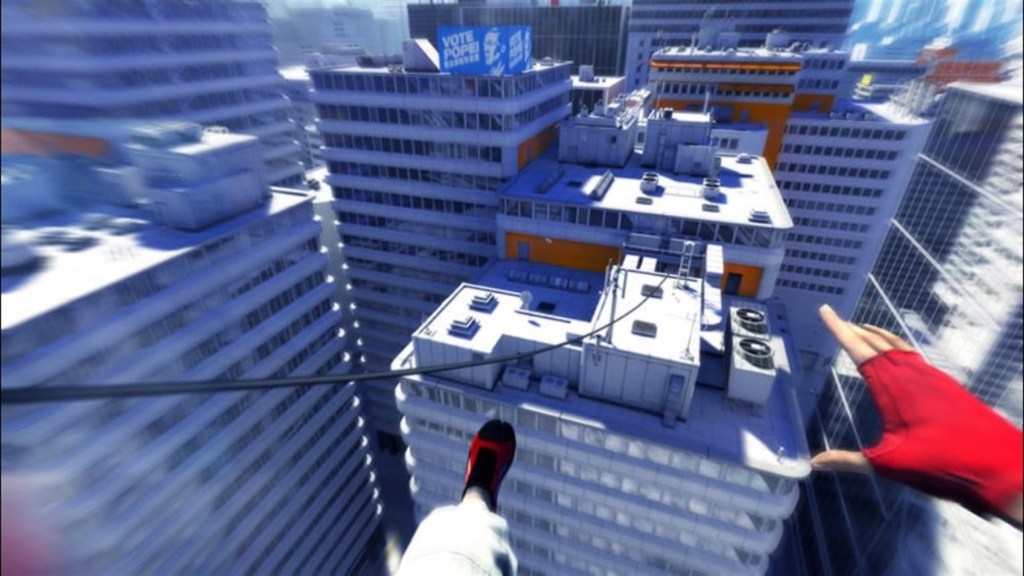17 years ago, Mirror’s Edge took a gameplay experiment and turned it into a cult classic. From the same studio that would go on to be defined by the Battlefield franchise, Mirror’s Edge was a stylish adventure/platforming game that operated on a singular gameplay thesis: parkour is cool. Players traversed an expansive city looking to upend a conspiracy, surviving perilous drops and trigger-happy cops along the way.
Videos by ComicBook.com
The real trick to Mirror’s Edge was the game’s commitment to a first-person perspective POV, with the game never abandoning that approach. The result was a minor hit that quickly developed into a cult classic among gamers taken by the title’s visual aesthetic and entertaining core gameplay. However, given the way technology has advanced in gaming in the years since, it’s a shame that Mirror’s Edge didn’t come out in the present day — as it could have become a much bigger hit for DICE Games.
Mirror’s Edge Was A Minor Hit Before Becoming A Cult Classic

Developed by DICE and published by Electronic Arts, Mirror’s Edge was a solid hit when it debuted on November 11, 2008, but I’m convinced the game’s constant first-person perspective would have been a genuine phenomenon if it had been tied to a VR approach. Focused on Faith Connors, the game forces players to control Faith through a series of first-person parkour sprints through a futuristic city. The story follows Faith’s work as a courier, known collectively as Runners, who deliver goods and intel under the noses of the police state that controls the city.
When her police officer sister is framed for the murder of a mayoral candidate, Faith sets off to uncover the truth and prove her sister’s innocence. Rooftop chases, impromptu zip lines, and wall jumps take on a different energy when it’s all depicted through first-person perspective. While critics at the time of release criticized the game’s focus on trial-and-error gameplay that could quickly become repetitive in the fairly linear levels, the game earned overall solid reviews and did well with audiences.
The game steadily developed into a cult classic, but has only received two follow-ups — 2010’s Mirror’s Edge mobile game prequel, and a reboot titled Mirror’s Edge Catalyst that was met with a far more mixed reception from critics and gamers in 2016. As the years have gone on, though, Mirror’s Edge focus on first-person platforming has lingered in many players’ minds as a clever twist on both the FPS and platforming mechanics. The bright visual aesthetic, intended to make the first-person platforming more streamlined and specific, lends the game a vibrant look that helps it stand out from other grittier games of the era. This unique visual touch also helped ensure the game developed a long-term following.
Why Mirror’s Edge Would Have Been Perfect For Now

The thing that makes Mirror’s Edge unique place in gaming history so notable is that it quietly predicted much of the developing technology surrounding first-person perspective gaming. By putting players directly into Faith’s shoes, they were given a new appreciation (and terror) about the dangerous stunts so many gaming characters encounter. It’s also the kind of game mechanic that, in retrospect, could have been a genuine killer app for the launch of a VR headset.
Setups like the Meta 3 or PlayStation VR could have furthered that layer of immersive engagement, opening up the full world around the player and fully placing them into Faith’s place in the world. Mirror’s Edge is a very immersive title on its own merits, but the disconnect that exists between the player’s perspective and the in-game action creates an unavoidable and natural break in full immersion.
If Mirror’s Edge had been released in an era where VR headsets were more commonly accessible by average gamers, it might have become a visually arresting and technologically impressive showcase for the potential of the hardware. Shockingly, Mirror’s Edge hasn’t been adapted for VR gameplay even now that the technology has caught up in a way that could have really highlighted the inventive design approach of first-person parkour in a massive city envrioment.
Mirror’s Edge Is Due For A Reboot

Mirror’s Edge is 17 years old today and has yet to receive the return that it deserves. The story mode, about a totalitarian government using constant surveillance to control a growing movement of revolutionary survivors in a major urban sprawl, feels far more timely than ever. The distinct and colorful pop of the visuals lends the game a timeless vibe that contrasts the political undertones, giving it an adaptability that few other games inherently carry. The first-person POV has been embraced by gamers, especially in the VR space.
A fully immersive Mirror’s Edge would be phenomenal, rewarding players who successfully pull off the game’s absurd jumps and slick moves with a visceral feeling of accomplishment. The fact that the game has never received a formal sequel also leaves the door open for developers to take Faith and the rest of her world in all sorts of directions.
Mirror’s Edge has a lot of modern potential, and it would have been a genuine smash in the current gaming environment that values immersion and advancement. Still, Mirror’s Edge remains a very inventive and unique title in modern gaming history. It will likely continue to grow as a cult classic until someone decides to bring the title back and gives it a chance to shine with new technological advancements.








